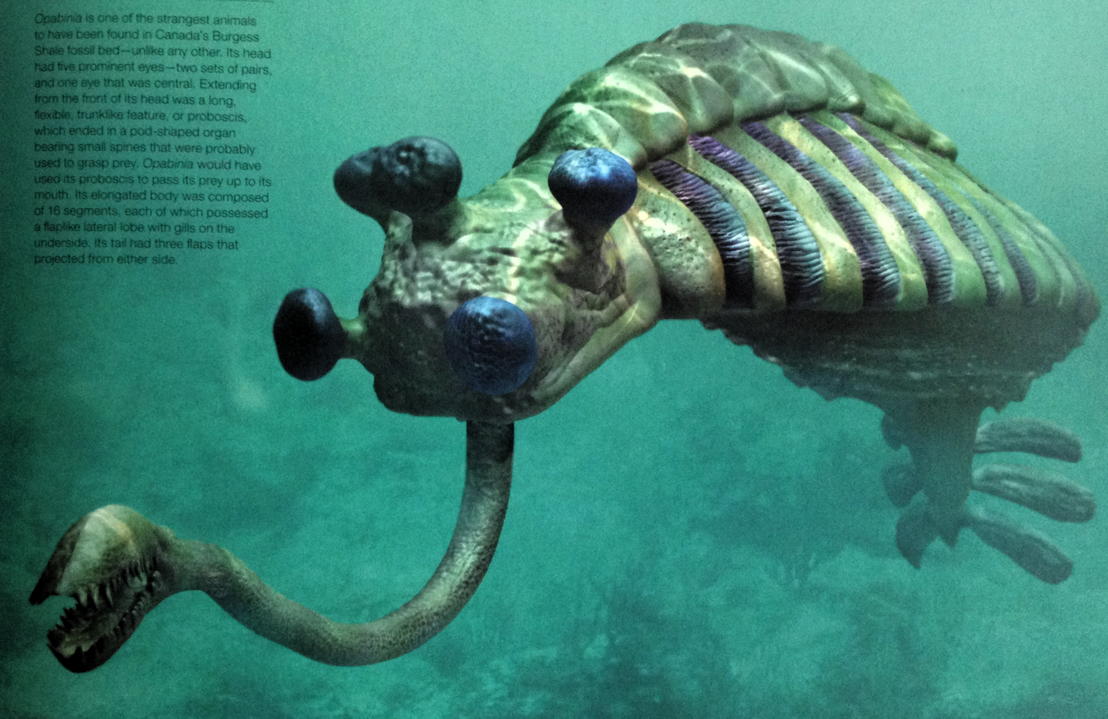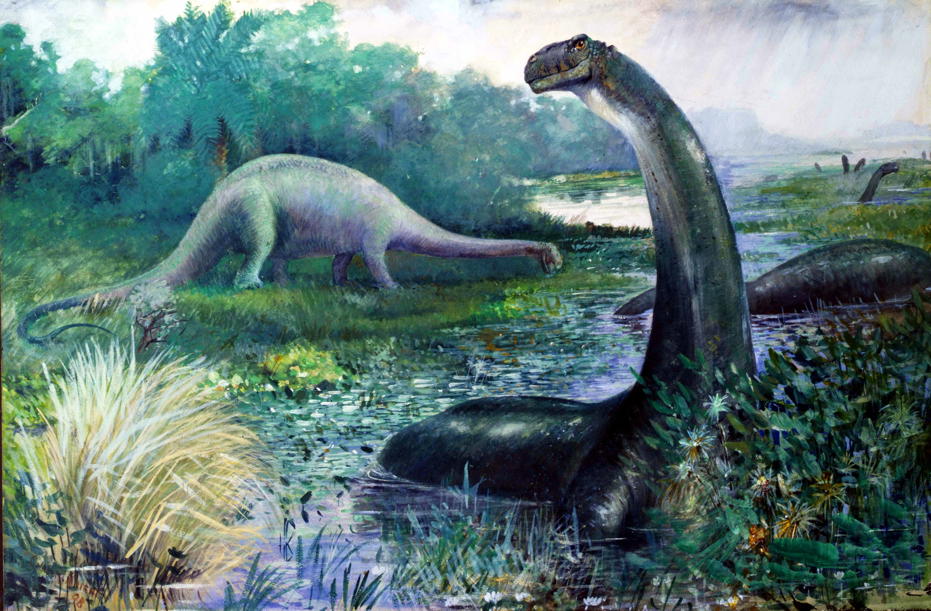Biblyon Broadsheet Review: Prehistoric life: The Definitive Visual History of Life on Earth
Dunkleosteus was a heavily armored fish, but its armor did not enclose its pectoral fins at the rear. This development allowed the fin base to increase in length and aided mobility, suggesting that Dunkleosteus was an active hunter in the shallow seas in which it lived.
Around the net
This lavishly illustrated book is a great resource for Guides wanting to go prehistoric on their players.

The opabinia, an invertebrate from the Cambrian, looks impressive here but was only a few inches long. No reason to tell your players that, however.
I remember devouring the dinosaur books in the local library while waiting for my parents to pick me up after school. When I got into D&D they formed a third of the triumvirate of go-to monsters in my adventures: skeletons, spiders, and dinosaurs.
I think one of the reasons I loved Larry DiTillio’s Chagmat from Dragon 63• is the unwritten assumption that the bonesnapper came from some underground lost world beneath the mountains (which, in my reskin, became an underground world ruled by intelligent spiders).
So I’ve been on the lookout for a good dinosaur compendium for a while, no longer having access to the books in that long-ago childhood hangout.
I found Prehistoric life• at the Barnes & Noble for DePaul University while wandering Chicago a few weeks ago. At $12.98 it was a no-brainer to pick it up. It’s huge, and lavishly illustrated. And while I have no idea if the strange illustrations match prehistoric reality, they’re perfect for mysterious and dangerous fantasy monsters.
The book is organized by time period, with a short description of the era’s climate, and a drawing of the shape of the continents. Both plants and animals are covered: within each era, the sections are plants, invertebrates, and vertebrates. Some lovely 10–20 meter tall ferns from the Carboniferous are described, for example.
Some of the names ought to inspire some unrelated fantasy creatures, for example, the “Serpent Rock” formed by the Carboniferous coral Siphonophyllia. That’s just the name of one of the fossils, but I can feel my subconscious already trying to churn out a monster called a serpent rock.

The corythosaurus, a vertebrate from the Cretaceous, were thirty feet long, and may have been notable for their “loud, resonating calls”.
The descriptions themselves are fairly sparse. Size is given, for example, but not mass. There is often a comparative silhouette next to a human to give a visual idea of a vertebrate’s size.
In the iconic Cretaceous, for example, we have the Irritator. The info box gives us only Group (Theropods), Date (Early Cretaceous), Size (8m long), and Location (Brazil), along with a description of when it was discovered and how much of its skeleton has been found.
It’s the photo-quality artwork that ought to get your creative juices flowing, however. The stats shouldn’t be that hard to make up once you decide how dangerous your prehistoric creatures need to be.
If there’s a disappointment in the book, it’s the lack of actively dangerous plant life. While in general this is more of a problem with nature than with the book’s completeness, the book itself is missing some entries. There is no mention that I can find, for example, of the Archaeamphora longicervia, though of course for gaming purposes even that would have to be exaggerated from its 2-inch height. (The lack of this makes it far from definitive, as well.)
That said, if you enjoy browsing about dinosaurs and other early life and you enjoy looking for strange new prehistoric creatures to add to your games, this makes a great idea stimulator. If you see it in your own Barnes & Noble I recommend browsing through it.
- April 12, 2015: Bronto burgers for everyone!
-
In my article “The Yellow Forest” for Fight On! issue 9, one of the encounters under the dinosaur breakout table was d6 brontosauri. The editors changed this to d6 apatosauri, keeping the faux-plural but using the generally-accepted replacement of the great thundering brontosaurus with the deceptive apatosaurus.
It’s a disappointment I’ve learned to live with. Ever since discovering that the brontosaurus, the great thunder lizard, never existed, I’ve refused to believe it, refused to replace it in my childish thoughts with the deceptive lizard.
After spending more than a century dismissed as a mislabeled Apatosaurus, Brontosaurus may be getting its identity back… The original Brontosaurus excelsus (meaning “thunder lizard”) was named in 1879. But in 1903, paleontologists decided that Brontosaurus excelsus was so similar to species in the Apatosaurus genus that it belonged there as well.
…
A small number of paleontologists have been campaigning for the dinosaur’s restoration since the 1990s, says Mossbrucker. “I certainly agree with the analysis that Brontosaurus excelsus deserves to be recognized as its own genus.”
The paleontologists pored over 81 skeletons of diplodocids and related dinosaurs, comparing more than 400 features in the animals’ bones. Instead of taking any species for granted, the team tallied up similarities between individual specimens.
“We can see which specimens group together and have particular characteristics that help identify them as a species,” says study coauthor Emanuel Tschopp, a paleontologist at the Universidade Nova de Lisboa in Monte de Caparica, Portugal. In most cases, the original designations about species held true, he said.
But the original Brontosaurus was distinct enough to deserve its own genus separate from Apatosaurus.
I’ve stuck with the old name because brontosaurus is so much richer a name than apatosaurus. Even its derivation evokes the image of great monsters thundering across the prehistoric world. The derivation of apatosaurus just confirms that scientists are easily confused.
If you enjoyed Prehistoric life: The Definitive Visual History of Life on Earth…
For more about prehistoric life, you might also be interested in Bronto burgers for everyone!, Giant saber-toothed leaping salmon, and Giant walking tanks that eat everything in their path.
- Archaeamphora at Wikipedia
- “The species was originally described as a pitcher plant with close affinities to extant members of the family Sarraceniaceae. This would make it the earliest known carnivorous plant and the only known fossil record of pitcher plants…”
- Dragon Magazine 63• (magazine)
- This was the second issue of Dragon that I saw, and the second that I ever owned. These two issues were the best Dragon magazines, and the best magazines, ever. Issue 63 contained one of the best adventures TSR ever published: The Chagmat. It also expanded on the humanoid creatures that adventurers love to fight, and it told us about “Coins through the ages”, one of the most-reread Dragon articles in my collection.
- Prehistoric Life: The Definitive Visual History of Life on Earth• (hardcover)
- While “definitive” is pushing it a bit, this is a great sourcebook on plant and animal life from the Archaean to the Quaternary and on into early human times.

